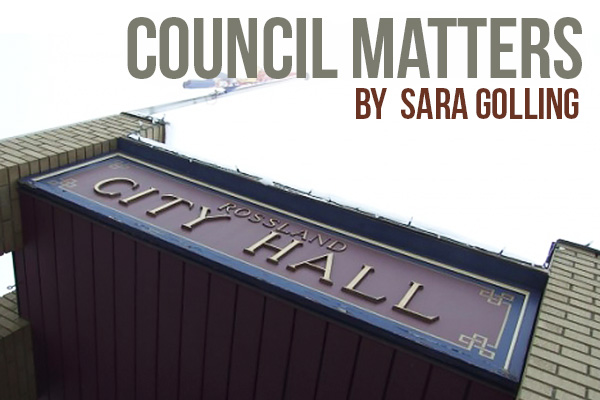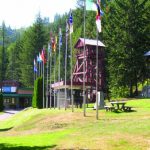BYLAW ENFORCEMENT AND DOGS, PARKING, AND SPEEDING. (MOSTLY DOGS.) OH, AND A PUBLIC HEARING, TOO.
All Council members except Marten Kruysse were present. (Kruysse has cycled across much of the continent to visit relatives.) This report includes only the Committee-of-the-Whole meeting and the Public Hearing held on Monday, July 13, 2015. I have reported on the regular Council meeting held immediately afterwards in a separate article.
July 13, 2015, 5:00 pm: COMMITTEE-OF-THE-WHOLE MEETING: BYLAW ENFORCEMENT ISSUES
Mayor Kathy Moore invited public comments on other issues first: A gallery member noted that it would be good to have a comment on the City’s position on fire preparation, in this dry hot season with lots of lightning. Moore spoke about the “fuel reduction” that ‘s been done in many areas of the forest surrounding Rossland, and Interim CAO Mike Maturo said that in the event of a threatening fire within the City perimeter , the City would set up an emergency operations centre, and call the provincial line for an “activation number” which would bring compensation for the City’s expenses, and expert advice. He said, “It’s important to remember that we’re not alone; there’s lots of assistance out there. … There is a good communication system, and good cross-border co-operation.”
Bylaw enforcement: the biggest issues the City hears about are dogs, parking, and speeding. Moore invited suggestions. Councillor Andrew Zwicker noted that bylaw enforcement may be akin to raising dogs and children, in that positive reinforcement for good behaviour is more effective than punishment, and must be the greater part of behavioural modification. He suggested improving the dog licensing program; and also noted that the City of Revelstoke started the “See-Click-Fix” program, and suggested that it could have a dog function added to it. Moore spoke of a similar use of an app that involves taking pictures of dogs wandering loose and sending them to an address for recording and action, and Zwicker suggested investigating all enforcement apps that may be available. That suggestion was approved by all.
Councillor Aaron Cosbey suggested Rossland trails could be divided into two categories: on-leash trails (the more heavily used ones such as Centennial, so that older people and children could walk those trails without fear of rambunctious or aggressive dogs) and off-leash trails (the more remote and less heavily used ones). Maturo added that the size and weight of dogs could be a factor in triggering the requirement for a leash.
Moore invited comments from the gallery: a resident encouraged the City to try segregating the trails, but noted that there would have to be significant penalties to have any effect. She also said that she has been very close to closing the well-used trail that runs across her land, because unleashed dogs have run further into her yard to chase and attack her cats. Moore added that more signage might help a bit — letting people know when trails use private property.
Sharon Wieder (of WildSafe) thought that education is a big factor; she spoke of the safety problems of dogs who chase bears within town, which could result in an upset bear running into someone else’s yard — and the owner could be in out their yard, vulnerable to an upset bear’s reactions. She also commented on the hazard posed by loose dogs in the woods (on trails) chasing and disturbing bears, then turning around and running back to their owners. She also stated that allowing dogs to chase bears is illegal; under the Fish and Wildlife Conservation Act, it’s illegal to let dogs run loose — that means off-leash — in areas inhabited by moose, elk, caribou and bears.
The recommendation to develop the idea to segregate trails into leash and off-leash CARRIED.
Councillor Lloyd McLellan said that enforcement requires follow-up; “Do we want to spend the money? Unless we’re prepared to designate someone to enforce — we’re just talking.” Moore noted that the current staff spend the small amount of time allotted for bylaw enforcement responding to complaints; and McLellan said that people just ignore the friendly call about their dog (or whatever). He stated that Council needs to identity a solution.
Cosbey thought it might be better to have the Commissionaires do the enforcement rather than one part-time staff member or an independent contractor. McLellan noted that flexible hours and flexible days are very important. Councillor John Greene said that other bylaws need enforcement too — such as the burning bylaw and parking.
Zwicker preferred the independent contractor solution. Cosbey asked what effect the collective agreement might have. Maturo said that the 2 hours a week dedicated for bylaw enforcement can still be used for that, in addition to an independent contractor’s time or a Commissionaire.
The recommendation to investigate options for additional enforcement of bylaws CARRIED.
Moore asked the gallery if they thought additional enforcement is needed and the gallery responded unanimously in favour of more enforcement: “It’s sadly lacking.” A resident related an incident in the 1990s when his mother-in-law was walking near the Post Office and was knocked down by a dog and struck her head very hard; from that incident on, her health deteriorated quickly and she died within a year. Another person also spoke about the number of dogs on Columbia Avenue; she no longer goes to the Farmer’s Market, because when she was last there, a dog peed on the corner of a vendor’s table. A resident said “it’s getting a bit out of hand with the dogs on the main street.” He related a number of incidents, and concluded that if there were another incident such as the one with the older woman being knocked down and injured, his family would sue the City because the City has a permissive bylaw and does not even enforce its minimal requirements. He also said that he likes and appreciates dogs, but said that downtown is not the place for them. Moore agreed that the City does need to enforce.
Maturo noted that in 2012 or 2013 the City had contemplated designating “tie-up” areas for dog owners to leave their dogs while they do errands in town, and that perhaps that idea should be revisited.
Councillor Andy Morel spoke about enforcement on the main drag, and suggested a dedicated “enforcement tour” of the downtown at about 4:00; Maturo said the staff’s shift ends at 3:30, and that the greatest traffic occurs from 4:00 to 6:00. Cosbey said, if education is important how do we accomplish that education effectively? Sharon Wieder suggested getting the business community on-side with promoting a campaign for responsible dog stewardship. Another gallery member said she was so glad Council was told about the incident of the injury near the post office, because that event was “top of mind” with her; and she has had guests tell her they would never go running in Rossland again because of aggressive dogs. She related an incident when she had to pay a $75 vet bill when one of her cats was bitten by an unleashed dog that ran into her yard to attack her cat; she said the dog problems are dangerous to people, discouraging to tourism, and dangerous to smaller pets. She recommends that the City’s website be brought up to date — it currently provides wrong information, and incomplete information — it refers to “municipal property” without defining that; a map would be useful; or it could state that dogs are allowed to run loose only in their own fenced yard. She noted that the City of Victoria has a clear definition of a “dangerous dog.” She suggested making the rules and penalties clear; and giving out a copy of the updated rules when people get their dog licences. The City should tell people “Don’t just complain — let us know.” She is much less concerned about the dog-poop issue, but is very concerned about the hazards.
Another resident spoke and agreed with the previous speaker’s points . She has experienced many incidents when she felt terrorized by dogs, and emphasized that she has never felt threatened by encounters with any wildlife, including bears.
Morel mentioned that a lot of dog owners ask about cat issues; cats who kill birds, and poop in other people’s yards; he suggested that the City look into how other jurisdictions deal with cats, and the suggestion CARRIED.
6:00 pm:
2. PUBLIC HEARING: OCP Amendment Bylaw #2593 and Zoning Amendment Bylaw #2594, to rezone the land at 2099 Third Avenue (formerly the Jehovah Hall) from P1 (Public and Institutional) to C2 — Commercial Service.
Deputy Corporate Officer Cynthia Añonuevo noted that the City had received no written submissions on the issue.
Resident Steward Spooner spoke, expressing concern about the potential for adding to traffic congestion on the street in future, even if the currently proposed use would not be a problem; he pointed out the C2 zoning would permit many other future uses, and he said congestion in that area is already a problem at some times. City Planner Stacey Lightbourne responded that Spooner is correct that C2 zoning allows for a number of potential uses, and the issue of traffic congestion could be addressed tonight. Maturo stated that the congestion could also be dealt with as and when required, by managing the traffic patterns instead of amending the bylaw.
Spooner made it clear that he has no problem at all with the proposed use of the property, but would like the City to control traffic congestion and its hazard for children and other pedestrians.
Elise Paré seconded Spooner’s concerns and talked about how much traffic now tends to use the lane rather than the streets bordering the property.
No one else spoke to the bylaws, and Council adjourned the Public Hearing and took a brief break before the regular Council meeting — reported separately for your reading enjoyment.
























